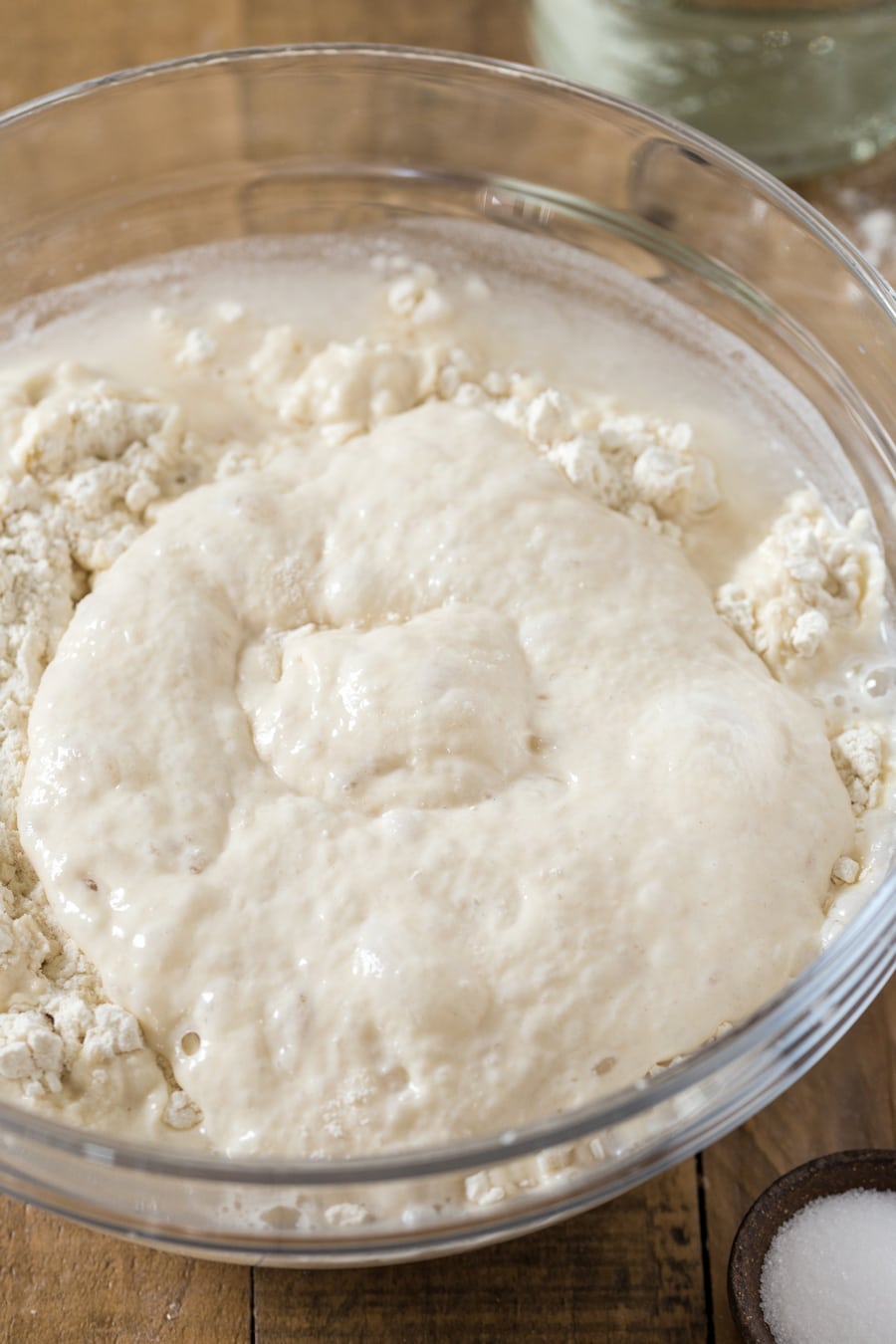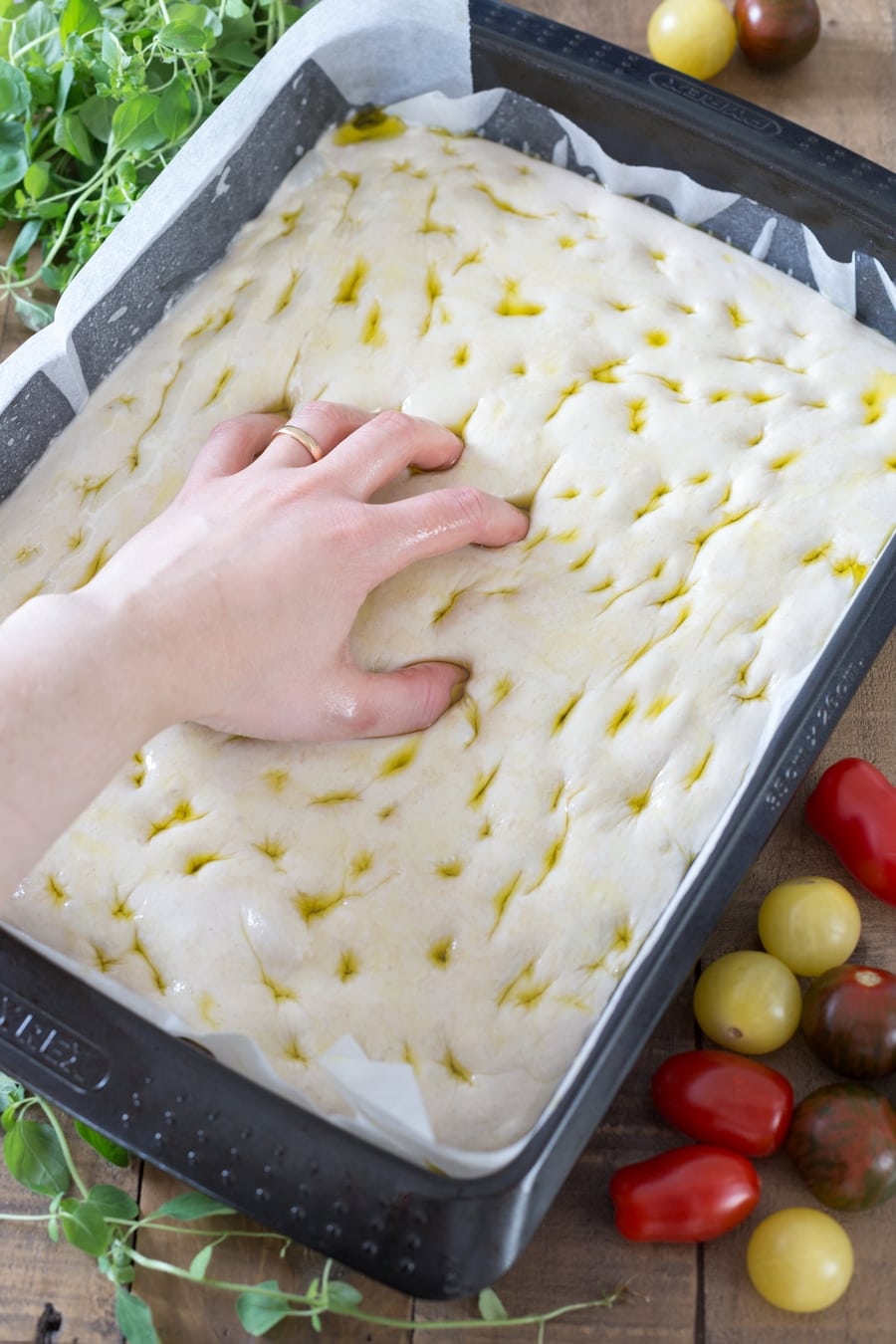Incredibly soft and full of flavour, poolish focaccia bread is a homemade focaccia made with a pre-ferment. If you want bakery-style focaccia bread, perfect to use for sandwiches, you need to make focaccia with a poolish. Top with good quality olive oil and cherry tomatoes for an irresistible snack or starter.

Focaccia bread with a pre-ferment
You may have seen those fabulously bubbly sourdough focaccia’s that are all the rage now on instagram. They’re all over my feed, and if you ended up reading this blog, chances are your feed might be as heavily food-oriented as mine.
I did, of course try my hand at sourdough focaccia myself using my sourdough starter and the result was fabulous. All those bubbles of air were what dreams are made of. Then I thought, what if I subbed the sourdough levain with a poolish?
The poolish formula is my favourite method to make pizza. If you have missed it, here’s my poolish pizza dough recipe. My pizza dough is thicker and harder than the focaccia recipe I usually follow, but I figured that the poolish formula could work just fine even with a more hydrated dough. And oh, it did.

How to make a poolish
If you’re unfamiliar with the concept of a poolish, to put it simply it is a pre-ferment. You combine the same amount of flour and water and stir in a minimal quantity of active yeast. You let it sit on the counter for 8-10 hours and this mixture will ferment and double in size. That is a mature poolish, which will be added to your pizza, focaccia or bread dough.
If you are familiar with sourdough bread baking, you will see that a poolish is pretty similar to a levain. Conceptually, it’s the same thing. A pre-ferment that gets added to the dough. Rather than mixing flour and water with sourdough starter, you add a tiny amount of yeast to trigger fermentation. I usually make it in the evening, and take care of the dough the following morning. You have to mix up the following:
- 75 g flour
- 75 g water
- a pinch of instant yeast (by pinch I mean, like 1/12 of a tsp)
And the following morning you will be greeted by this:

As you can see a mature poolish is rather bubbly and has a lot of volume. I made mine in a see-through jug in order to show the poolish texture in the pictures. Please notice that the poolish in this picture is a double dose, as I was making a double batch of focaccia. A mixture of 150 g of flour and 150 g of water took up less than half of the container initially. But once mature my poolish nearly took up all of the jug, which has a capacity of 1 litre. So even if making one batch (as per the ingredients listed in this recipe) make your poolish in a container that allows enough room to double in size.
How to make poolish focaccia dough
A poolish will reach maturity after about 8-10 hours, which is when it’s recommended to use. I have stretched it as far as 20 hours, but the longer it sits the more it will deflate and lose its strength. So time your focaccia wisely and plan accordingly. I usually make the poolish the evening before and make the focaccia dough the following morning. I love ending my day mixing flour and water and waking up to witness the magic of fermentation!
Here’s what you will need to make poolish focaccia dough:
- all of your mature poolish
- 500 g strong flour (my favourite is Manitoba, if possible use any flour over 13% protein)
- 425 g water
- 14 g salt

- Combine the ingredients together stirring them in a bowl using a wooden spoon or rubber spatula. Once the mixture is homogeneous, cover it with cling film and let it sit for 20 minutes. This process is called autolyse.
- After that, mix your dough with an electric mixer fitted with dough attachments for 5 minutes at low speed, then another 5 minutes at medium speed.
Bulk fermentation & proofing
- Set the mixer aside and let the dough rest in the same bowl. During the first 2 hours you will need to do 4 sets of stretch and fold every half hour. Again, this may sound familiar if you do some sourdough bread making at home, but if this sounds new to you, it’s rather simple, really.
- Stretch and fold: Wet your hand and slide it under the dough, catch it from below and lift one side upwards gently stretching it, then fold it over. Turn the bowl 90° and repeat: slide hand below, stretch upwards, fold over. Turn the bowl another 90° and repeat. You dont need to knead it much, apart from making sure you have stretched and folded the dough from all 4 cardinal points. A dough with a high hydration ratio is rather runny so you can easily do the stretches and folds keeping the dough in the bowl.
- Set a timer and perform 4 sets of stretches and folds throughout the first 2 hours – every 30 minutes. Keep the dough covered with cling film in between sets. After the final set, you can transfer the dough to the baking tin for proofing.
- Lightly oil the tin, then press a sheet of baking paper against it. Add more oil over the baking paper and spread it all over the surface. Transfer the dough by gently scraping it down from the bowl into the baking pan. Lightly stretch it to fit the whole tin.
- Pour a generous amount of olive oil all over the surface. Do we have a fixed quantity? No, not really. I just pour it from the bottle, making sure to have some oil land all over the focaccia surface (see picture below).
- Let the dough proof for about 4 hours at room temperature – ideally in the sun or in the kitchen or in the warmest corner of your house.
- After about 4 hours, the dough may have formed some bubbles of air, but from my experience they won’t be as big and dramatic as those that develop when using a sourdough starter. Properly coat your hand with more olive oil and proceed to press your fingers into the dough to create the typical focaccia pattern. This redistributes the pockets of air inside the dough. As you can see in the image below the dough is rather thick and soft, judging by how my fingers sink into it. This is more or less what you should be expecting to get. Also, my pan is 35*26 cm (13*10 inches).
- A sprinkle of more olive oil won’t hurt. Go ahead, focaccia is meant to be drenched in olive oil. It’s what makes it so good.
Poolish focaccia filling
While you could just stop right there, as in sprinkle some salt and bake, I really vouch for adding some sort of topping to your focaccia. Plain focaccia bread is great if you want to use it for sandwiches and add some filling, like in this wonderful caprese focaccia sandwich. But if you want to enjoy your poolish focaccia on its own as a starter, or as bread along a charcuterie board, a topping will make it a lot yummier.
The poolish focaccia I’m featuring here got to be a cherry tomato and oregano focaccia, so – quite obviously – here’s what goes into the topping:
- cherry tomatoes
- oregano – both dried and fresh
- olive oil (yesss! More!!)
- salt flakes
- Halve the cherry tomatoes and add them to a bowl. Sprinkle some salt, dried oregano and olive oil and toss to mix.
- Press the cherry tomatoes all over the surface of the poolish focaccia, cut facing up.
- Sprinkle some more salt flakes all over the focaccia.

- Bake the focaccia in the preheated oven at 230°C (450°F) for 20-25 minutes.
- If you have fresh oregano available, you can add some to the focaccia as garnish. Please notice that the leaves go brown if placed on hot focaccia, so reserve this decoration if serving the focaccia cooled.

Foe an extra luxurious – and very Italian – addition, you should try to squeeze some whipped mascarpone out of a piping bag here and there. Or how about some Marsala caramelized onion that you have lightly warmed in the microwave just before landing it on the focaccia?

Focaccia made with a poolish has a lovely texture, in the perfect middle between airy and compact. It is excellent for dipping into sauces (try this eggplant ricotta dip!), great as sandwich bread (caprese focaccia sandwich is my favourite vegetarian sandwich) or just excellent finger food to snack on while sipping a Campari soda.
Whether it is an Italian-themed dinner party that requires some bread on the table, or you want to jazz up your sandwich bread options, the poolish formula surely delivers some bakery-style stuff even if you don’t have a sourdough starter in your fridge.
Poolish focaccia bread with cherry tomatoes
Equipment
- Mixing bowls
- Electric mixer with hook attachment
- 35*26 cm baking tin
Ingredients
For the poolish pre-ferment
- 75 g flour
- 75 g water
- 1/12 tsp active dry yeast
For the focaccia dough
- 500 g flour Manitoba recommended
- 425 g water
- 14 g salt
- 60 ml olive oil
For the topping
- 250 g cherry tomatoes
- 1/4 tsp dried oregano
- 2 tbsp olive oil
- salt flakes
- 1 bunch fresh oregano optional
Instructions
Poolish pre-ferment (made 8-10 hours in advance)
- Combine poolish ingredients together in a bowl and stir until homogeneous. The bowl used need to have enough capacity for the mixture to double up in size. Cover with cling film and leave to ferment at room temperature overnight (8-10 hours).
Poolish focaccia dough
- Combine the flour, water, 14 g of fine salt and all of the mature poolish and stir until homogeneous. Cover with cling film and let sit for 20 minutes (autolyse).
- After 20 minutes, mix the dough with an electric mixer fitted with hook attachments for 5 minutes at low speed, then another 5 minutes at medium speed.
- Wet your hand and slide it under the dough, catch it from below and lift one side upwards gently stretching it, then fold it over. Turn the bowl 90° and repeat: slide hand below, stretch upwards, fold over. Turn the bowl another 90° and repeat until you have stretched and folded the dough from all 4 cardinal points.
- Repeat stretch and dough procedure 4 times, every 30 minutes, during the first 2 hours. Keep the dough in the bowl, covered with cling film in between stretch and fold sets.
- Spread some olive oil onto a baking tin, then press down a baking paper sheet. Spread more oil over the baking paper, distributing it all over the surface.
- After the last stretch and fold set, transfer the dough tot he baking tin, gently pulling it to fit the new container. Aprinkle some more oil over the focaccia surface, cover with cling film and let rest for 4 hours at room temperature.
Topping
- Halve the cherry tomatoes and add them to a bowl. Add dried oregano, salt and olive oil and toss.
- Coat your hand with more olive oil and proceed to press your fingers into the dough to create the typical focaccia pattern. This redistributes the pockets of air inside the dough.
- Press the cherry tomatoes onto the focaccia dough, cut facing up. Sprinkle some salt flakes all over the focaccia surface.
- Bake the focaccia in the preheated oven at 230°C (450°F) for 20-25 minutes.
- If you have fresh oregano available, you can add some to the focaccia as garnish. Please notice that the leaves go brown if placed on hot focaccia, so reserve this decoration only if serving the focaccia cooled.













What will be a good conversion (percentage) if I want to use sourdough Starter, instead of yeast?
Thank you.
I don’t have the answer right now but you could take a look at this post: https://electricbluefood.com/poolish-pizza-dough/
While I focus mostly on making a pre-ferment with a tiny amount of yeast, I also suggest a pre-ferment with sourdough starter instead of yeast. You could use that and then follow the rest of the directions for the focaccia. I haven’t tried myself so please be aware that this is just a suggestion.